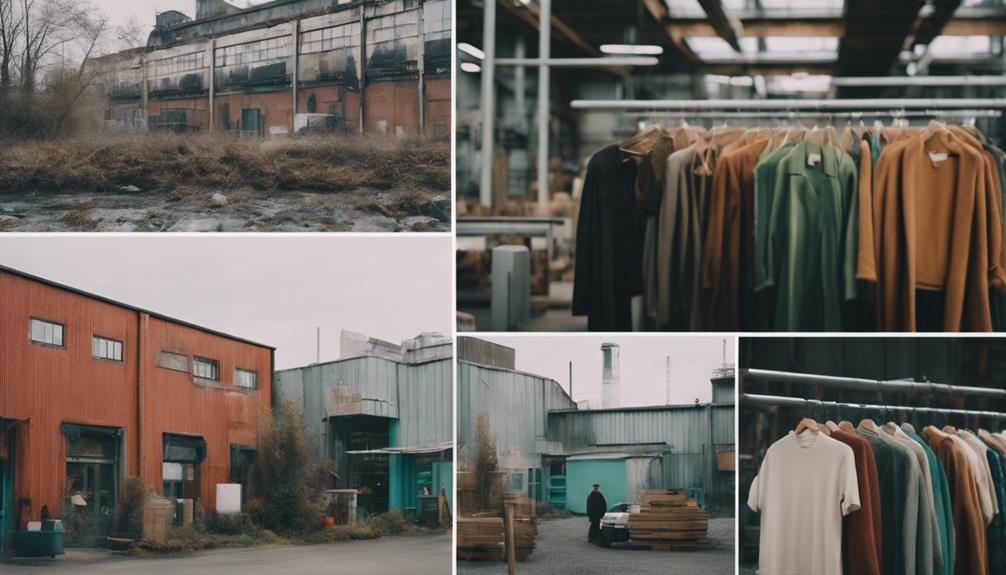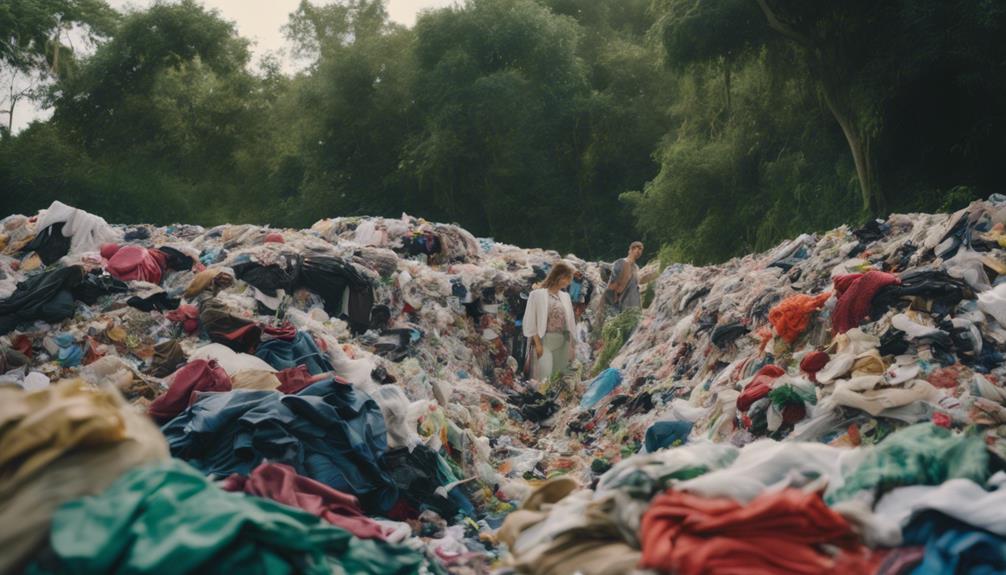The distinction between ethical and sustainable fashion might catch you off guard. Ethical fashion emphasizes fair labor practices, ensuring workers have safe conditions and receive decent wages. It is centered around people, particularly vulnerable communities, often women in the garment industry. On the other hand, sustainable fashion concentrates on eco-friendly practices to minimize environmental harm, such as utilizing organic materials and reducing carbon emissions. While both are aimed at creating a brighter future, they address different issues. Understanding how these two approaches intersect can enhance your comprehension of fashion’s impact on the world, and there is much more to learn about responsible choices in today’s industry.
Key Takeaways
- Ethical fashion focuses on fair labor practices and worker welfare, particularly for marginalized groups like women in the Global South.
- Sustainable fashion emphasizes eco-friendly materials and practices to minimize environmental impact.
- Ethical concerns highlight safe working conditions, while sustainable concerns revolve around reducing carbon emissions and waste.
- Both approaches are interconnected; exploitation in labor undermines sustainability efforts in the fashion industry.
Understanding Ethical Fashion
Ethical fashion prioritizes fair labor practices and safe working conditions, ensuring that garment workers are treated with dignity and respect. This movement addresses significant issues like gender equity, as around 85% of the workforce in garment manufacturing comes from women, often subjected to unsafe environments and unfair wages. In many regions, these workers earn as little as $4.66 per hour, far below the federal minimum wage in the U.S.
The rise of ethical fashion counters the harmful practices associated with fast fashion, which often exploits workers throughout the supply chain. By advocating for human rights and fair working conditions, ethical fashion brands are making conscious decisions to partner with local suppliers who provide living wages and improved labor conditions. This shift not only enhances the quality of life for garment workers but also promotes sustainable practices that can lead to a healthier environment.
In essence, embracing ethical fashion means supporting a system that values the well-being of those who create our clothing, challenging the status quo of an industry often plagued by neglect and exploitation.
Exploring Sustainable Fashion

Sustainable fashion prioritizes eco-friendly practices that considerably reduce the environmental impact of clothing production. By focusing on natural materials like organic cotton and bamboo, you can contribute to a healthier planet. The fashion industry is a major contributor to carbon emissions, so making conscious choices is essential.
Here are four key aspects of sustainable fashion:
- Eco-Friendly Materials: Opt for clothing made from organic cotton, bamboo, and other sustainable fabrics that minimize environmental harm.
- Waste Reduction: Engage in reuse and recycle practices, such as upcycling old garments and choosing second-hand shopping, to help combat textile waste.
- Innovative Technologies: Look for brands employing waterless dyeing processes and other innovative methods that reduce the ecological footprint of production.
- Fair Treatment of Workers: Support brands that treat their workers fairly, as ethical fashion intersects with sustainability in ensuring humane working conditions.
Key Differences Explained

While both ethical and sustainable fashion aim to create a positive impact, the former prioritizes worker welfare, whereas the latter focuses on minimizing environmental harm. Understanding these differences can help you make informed choices about the fashion brands you support.
| Aspect | Ethical Fashion | Sustainable Fashion |
|---|---|---|
| Focus | Worker welfare and fair labor | Minimizing environmental impact |
| Main Concerns | Safe working conditions in garment factories, especially for women in the Global South | Eco-friendly materials and practices |
| Risks | Greenwashing, misleading claims | Overemphasis on sustainability without addressing labor issues |
Ethical fashion emphasizes social justice, ensuring that workers are treated fairly and work in safe environments. Meanwhile, sustainable fashion aims to reduce the industry's environmental footprint, addressing issues like greenhouse gas emissions. However, both approaches are interconnected; a sustainable brand may lose its value if its eco-friendly products are produced under exploitative conditions. To truly support ethical and sustainable fashion, you need to look beyond marketing and understand the practices behind the labels.
Evaluating Ethical and Sustainable Choices

When evaluating fashion choices, it's essential to reflect on both the treatment of workers and the environmental impact of the brands you support. By making informed decisions, you can contribute to a more ethical and sustainable fashion landscape.
Here are four key factors to take into account:
- Garment Workers: Confirm the brands you choose prioritize fair wages and safe working conditions for their workers.
- Eco-Friendly Materials: Look for brands that use organic materials and sustainable practices to minimize environmental impacts.
- Production Transparency: Research the brand's production processes to understand their commitment to ethical fashion.
- Mindful Shopping: Before purchasing, reflect on the long-term impact of your choices on both people and the planet.
Supporting Responsible Fashion Practices

Supporting responsible fashion practices means actively choosing to back brands that prioritize ethical labor and environmental sustainability. By researching brands, you guarantee your purchases support workers and the environment. Fashion refers to more than just clothing; it's about the impact your choices have on people and the planet.
When you're buying ethical and sustainable, consider supporting local artisans and brands that use natural fibers, which greatly reduce environmental harm. Engaging in the #nonewclothes pledge can shift your focus toward restyling or swapping clothing, which cuts down on waste and promotes a more sustainable wardrobe.
Additionally, advocating for policy changes can lead to systemic improvements in the industry, benefiting marginalized communities and promoting equitable practices. You can further your understanding through educational resources—often available via email newsletters from ethical brands—empowering you to make informed decisions.
When you view the fashion industry through a critical lens, you'll recognize that your choices can drive demand for responsible practices, ultimately shaping a more ethical and sustainable future. Every decision counts, so support brands that align with your values and contribute to a better world.
Frequently Asked Questions
What Is the Difference Between Sustainable and Ethical Fashion?
When you explore the difference between sustainable and ethical fashion, you'll find that ethical fashion focuses on fair labor practices, while sustainable fashion emphasizes reducing environmental impact. Both aim for responsible production, but tackle different concerns. Sustainable fashion also encompasses the use of eco-friendly materials and innovative production techniques to minimize waste and pollution. On the other hand, ethics in fashion extend to animal welfare, social justice, and transparency throughout the supply chain. Both sustainable fashion and ethics are important considerations for consumers looking to make more conscious choices in their clothing purchases. By understanding the differences and overlaps between the two, individuals can make informed decisions that align with their personal values and beliefs.
What Is the Problem With Sustainable Fashion?
Sustainable fashion often faces criticism for relying on materials sourced unethically, contributing to waste and confusion about eco-friendly choices. You might find brands misleading consumers, making it hard to distinguish between genuine sustainability and greenwashing.
What Does Sustainable Fashion Mean to You?
Sustainable fashion feels like a refreshing change, doesn't it? It means embracing choices that nurture our planet, valuing quality over quantity, and wearing garments that reflect your commitment to a healthier, brighter future.
How Does Sustainability Relate to Ethical Decision Making in the Clothing Industry?
Sustainability in fashion means considering environmental impacts, while ethical decision-making focuses on fair labor practices. You can't prioritize one without the other; both are essential for creating a responsible and just clothing industry.
Conclusion
In the world of fashion, understanding the difference between ethical and sustainable practices can feel like splitting hairs, but it's essential.
Ethical fashion focuses on fair labor and humane production, while sustainable fashion emphasizes environmental impact.
By knowing these distinctions, you can make informed choices that resonate with your values.
So, next time you shop, remember: it's not just about looking good; it's about feeling good too.
Embrace your role in fostering responsible fashion!









